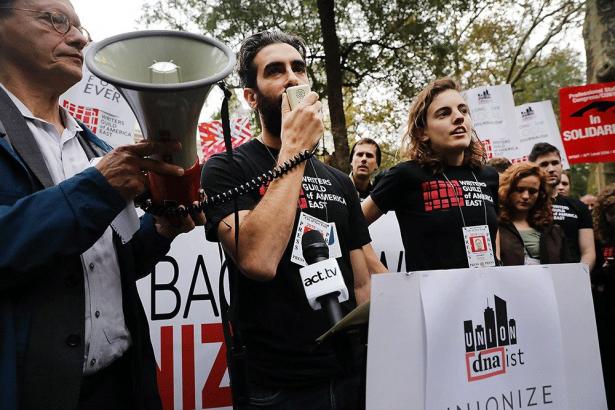OXFORD, Miss. - When highly successful columnist Heywood Broun called for a union of newsrooms workers across America nearly 90 years ago, he reminded his fellow journalists of their misperceptions about themselves.
“The men who make up the papers of this country would never look upon themselves as what they really are—hacks and white collar slaves,” Broun wrote in his August 7, 1933, column for the New York World Telegram. “Any attempt to unionize leg, re-write, desk or makeup men would be laughed to death by these editorial hacks themselves.”
Those hacks looked down on the unionized, blue-collar printers in the same building, yet the printers earned an average 30 percent more than the reporters and editors.
Broun is smiling from heaven these days at the resurgence of union activity in newsrooms across the country. Like their counterparts at Starbucks coffee shops from the East to the West Coast, newsroom working stiffs are brandishing their union cards. The NewsGuild that Broun helped establish has more than 6,300 members who’ve joined in just the past four years. Another 2,400 joined the Writers Guild of America, East, over the past eight years.
“I watched too many decent people stripped of their professional dignity,” columnist Mike Kelly of the New Jersey-based The Record told veteran labor reporter Steven Greenhouse. “We were watching our colleagues just pushed out the door willy-nilly and without any warning.”
Kelly referred to the standard Gannett company practice of buying newspapers like The Record and quickly eliminating staff. Also swelling the ranks of newsroom union card holders was the COVID-19 pandemic, which proved not only to reporters and editors but to workers around the nation and world that they were less important than the bottom line in the eyes of their employers.
A key figure in the growth of unions among newsroom workers is Hamilton Nolan, who now covers Southern labor activity for the Chicago-based magazine In These Times. Back in 2015, Nolan worked for Gawker Media and led his fellow journalists to make it the first big-sized digital media outfit to unionize.
Gawker later had to declare bankruptcy after losing a legal battle with nationally known wrestler Hulk Hogan. However, the unionization of its newsroom inspired similar labor actions across the digital news world as well as at old established outfits like the Chicago Tribune and Los Angeles Times.
Young people are leading the way at these news organizations, much as they are at Starbucks, where Rhodes scholar and University of Mississippi graduate Jaz Brisack helped start a union movement that spread from the Buffalo, New York, Starbucks where she worked as a barista to other Starbucks stores across the country.
Both Nolan and Brisack, a former student of mine, recently stopped in Oxford, Mississippi, to visit this old labor writer to talk about the labor movement in the South. While much attention was paid to the failed union effort at the Amazon plant in Bessemer, Alabama, the media haven’t much noticed other labor activity in the region.
Starbucks workers here in Oxford are now calling for a union. The firing of seven pro-union workers at a Memphis Starbucks has galvanized the movement with the Rev. William Barber leading a recent march in their support. Newsroom workers at newspapers in Dallas, Austin and Fort Worth, Texas, are already unionized and calling on management to finalize contracts. All three—the Dallas Morning News, Austin American-Statesman and Forth Worth Star-Telegram—have been unionized only since July 2020, the first in Texas in 30 years, and this will be their first contracts.
Perhaps in part because of what’s going on inside these and other newsrooms, labor coverage nationwide is on the rise in the U.S. media. Labor reporters, who had almost disappeared from the landscape a decade or more ago, are now back on the beat at at least a dozen or more major news organizations. This may also be a reflection of a recent Gallup poll that shows a whopping 68 percent of Americans support unions despite an overall decline in union membership.
As evident with these newspapers and Starbucks shops, the South is seeing some of this union activity. Despite its anti-union reputation, the South has a long labor history that includes the successful organizing of sharecroppers and tenant farmers in Arkansas in the 1930s, Martin Luther King’s support of the ultimately successful unionizing effort among sanitation workers in Memphis in the late 1960s, textile workers’ victory in North Carolina in the 1970s, and catfish workers organizing in the Mississippi Delta in the 1990s.
Back during the 1930s, Heywood Broun backed up his column with frontline organizing and became a hero of the movement. “I think I could be happy on the opening day of the general strike if I had the privilege of watching (wealthy and influential Establishment journalist) Walter Lippmann heave a half a brick through a Tribune window at a non-union operative who had been called in to write the current (Lippmann’s) Today and Tomorrow column on the gold standard.”
Let’s hope Broun’s spirit continues to live and prosper among today and tomorrow’s ink-stained wretches.
Joseph B. Atkins is a veteran journalist and writer on labor issues who teaches journalism at the University of Mississippi. He is the author of Harry Dean Stanton: Hollywood’s Zen Rebel (University Press of Kentucky, 2020),Covering for the Bosses: Labor and the Southern Press (University Press of Mississippi, 2008), and the novel Casey’s Last Chance (Sartoris Literary Group, 2015). His blog is http://www.laborsouth.blogspot.comand he can be reached atjbatkins3@gmail.com.


Spread the word